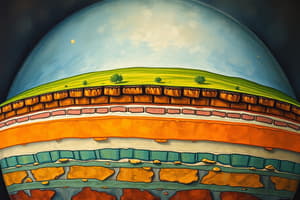Podcast
Questions and Answers
Which layer of the Earth is primarily responsible for Earth's magnetic field?
Which layer of the Earth is primarily responsible for Earth's magnetic field?
- Mantle
- Inner Core
- Outer Core (correct)
- Crust
What percentage of the Earth's atmosphere is made up of oxygen?
What percentage of the Earth's atmosphere is made up of oxygen?
- 28%
- 35%
- 50%
- 21% (correct)
Which Earth subsystem includes all forms of water, both on the surface and underground?
Which Earth subsystem includes all forms of water, both on the surface and underground?
- Hydrosphere (correct)
- Lithosphere
- Atmosphere
- Biosphere
What is the composition of the Earth's crust?
What is the composition of the Earth's crust?
Which process can affect ecosystems as part of the interconnection among Earth's subsystems?
Which process can affect ecosystems as part of the interconnection among Earth's subsystems?
Which subsystem is defined as the global sum of all ecosystems?
Which subsystem is defined as the global sum of all ecosystems?
What is the primary component of the Earth's inner core?
What is the primary component of the Earth's inner core?
Which layer of the Earth is involved in tectonic processes and landforms?
Which layer of the Earth is involved in tectonic processes and landforms?
Flashcards are hidden until you start studying
Study Notes
Earth Science Overview
- Earth science is the study of the Earth and its processes, including the atmosphere, hydrosphere, lithosphere, and biosphere.
- It integrates various disciplines, such as geology, meteorology, oceanography, and environmental science.
Earth
- Earth is the third planet from the Sun and the only known planet to support life.
- Composed of several layers:
- Crust: Earth's outermost layer, consisting of solid rock.
- Mantle: Layer beneath the crust, composed of semi-solid rock that flows slowly.
- Outer Core: Liquid layer made of iron and nickel, responsible for Earth’s magnetic field.
- Inner Core: Solid, dense center composed mainly of iron.
Earth Subsystems
-
Atmosphere
- The layer of gases surrounding the Earth.
- Composed primarily of nitrogen (78%) and oxygen (21%).
- Plays a crucial role in weather, climate, and protection from solar radiation.
-
Hydrosphere
- Encompasses all water on Earth, including oceans, rivers, lakes, and groundwater.
- Covers about 71% of the Earth’s surface.
- Vital for all forms of life, weather patterns, and climate regulation.
-
Lithosphere
- The rigid outer layer of the Earth, consisting of the crust and upper mantle.
- Composed of rocks and minerals; involved in tectonic processes and landforms.
- Home to soil, which supports terrestrial life.
-
Biosphere
- The global sum of all ecosystems, where life exists.
- Interactions between living organisms and their environments.
- Includes terrestrial (land) and aquatic (water) ecosystems.
Interactions Among Subsystems
- Earth’s subsystems are interconnected; changes in one can affect the others.
- For example:
- Climate change (atmosphere) can alter water availability (hydrosphere).
- Erosion (lithosphere) can impact ecosystems (biosphere).
- Understanding these interactions is crucial for environmental management and sustainability.
Earth Science Overview
- Study of Earth and its processes, incorporating atmosphere, hydrosphere, lithosphere, and biosphere.
- Interdisciplinary approach combines geology, meteorology, oceanography, and environmental science.
Earth
- Third planet from the Sun; unique for supporting life.
- Composed of several distinct layers:
- Crust: Outermost layer made of solid rock.
- Mantle: Beneath the crust, semi-solid rock that flows slowly.
- Outer Core: Liquid layer of iron and nickel, generates Earth's magnetic field.
- Inner Core: Solid, dense center primarily made of iron.
Earth Subsystems
-
Atmosphere
- Gaseous layer encasing Earth, essential for life.
- Composed of 78% nitrogen and 21% oxygen, influences weather and protects against solar radiation.
-
Hydrosphere
- Includes all of Earth's water: oceans, rivers, lakes, and groundwater.
- Covers 71% of Earth's surface, crucial for life and regulating climate.
-
Lithosphere
- Rigid outer layer made of crust and upper mantle.
- Contains rocks, minerals, and soil; involved in tectonic activity and land formation.
-
Biosphere
- Totality of all ecosystems on Earth, where life thrives.
- Interaction between organisms and environments, encompassing terrestrial and aquatic ecosystems.
Interactions Among Subsystems
- Subsystems are interconnected; changes in one can lead to effects in others.
- Climate changes (atmosphere) influence water availability (hydrosphere).
- Erosion processes in the lithosphere can disrupt ecosystems (biosphere).
- Understanding these relationships is vital for effective environmental management and sustainability initiatives.
Studying That Suits You
Use AI to generate personalized quizzes and flashcards to suit your learning preferences.




